Charging batteries with solar panels is a smart way to use renewable energy. It makes us less dependent on traditional energy and helps the planet. You need a solar panel and a charge controller to do this. These tools turn sunlight into electricity that goes into a battery.

Using solar panels to charge batteries is perfect for being off the grid. A 100-watt solar panel can keep a car battery charged in the sun. For a 12V battery with 100 Ah, you need 1200 Wh to fully charge it. This shows how important it is to pick the right solar panel size for charging.
By using solar power, we can cut down on non-renewable energy. This helps us move towards a greener future.
Key Takeaways
- Solar panel charging is a renewable energy source that reduces our carbon footprint.
- A charge controller is necessary for solar panel charging to prevent overcharging and damage to the battery.
- The efficiency of solar panels in charging batteries is influenced by sunlight availability, panel orientation, and shadowing.
- A minimum of 100 watts of solar energy is required to fully recharge a 100-amp-hour battery within a few days.
- MPPT charge controllers have a 30% greater energy storage efficiency compared to PWM charge controllers.
- Solar panel charging is a great way to charge your batteries, even when you’re off the grid.
- Charging batteries with solar panels promotes energy independence and a sustainable future.
Understanding Solar Battery Charging Basics
Solar battery charging is key to using sustainable power from the sun. It turns sunlight into electricity with solar panels. This electricity is then stored in batteries for later use. This tech is vital for energy independence, mainly in places far from power sources.
The solar battery charging process is simple. Solar panels change sunlight into DC power. A charge controller then keeps the battery from getting too full or too empty. This way, the battery can power many devices, giving a steady off-grid energy source.
Some main perks of solar battery charging are:
- Renewable energy source
- Energy independence
- Low maintenance costs

Learning about solar battery charging helps people make smart choices about their energy needs. It’s a good option for homes and businesses wanting to cut down on traditional power use. It’s all about moving towards sustainable poweroptions.
| Solar Panel Size | Power Output |
|---|---|
| 250W | 200-250Wh |
| 400W | 320-400Wh |
Benefits of Solar Battery Charging
Solar battery charging has many benefits. It can lower your energy costs and make you more independent. By using renewable energy from the sun, you can cut down on your use of grid electricity. This can lead to big savings on your energy bills.
It also supports sustainable power and helps reduce carbon emissions. This makes it a great choice for those wanting to lessen their environmental impact.
Some key benefits of solar battery charging include:
- Energy efficiency: Solar battery chargers can store and use energy with up to 20% efficiency.
- Convenience: Portable solar battery chargers are easy to carry. They’re perfect for outdoor activities and emergency kits.
- Cost savings: Using solar power can save you 50% to 80% on your energy costs.
As we move towards renewable energy, solar battery charging is becoming more important. Its benefits and advantages are why more people are using solar battery chargers. The use of these chargers is expected to grow by about 20% from 2021 to 2028.

In summary, solar battery charging is a reliable, efficient, and cost-effective way to use sustainable power. As technology gets better, we’ll see even more innovative solar energy solutions.
| Solar Panel System | Ideal Battery Size |
|---|---|
| 4kWh solar panel system | 3-4kWh solar battery |
| 5kWh solar panel system | 4-5kWh solar battery |
| 6kWh solar panel system | 5-6kWh solar battery |
| 8kWh solar panel system | 10kWh solar battery |
| 10kWh solar panel system | 15kWh solar battery |
Essential Components for Charge Battery Solar Power Systems
Setting up a solar-powered battery charging system needs key components for efficiency and safety. It’s important to know about solar panel specifications, charge controllers, and battery types. This knowledge helps make the most of your system.
Solar panels turn sunlight into electrical energy. The solar panel specifications you pick affect your system’s performance. Monocrystalline panels are the most efficient, while polycrystalline panels are more affordable.
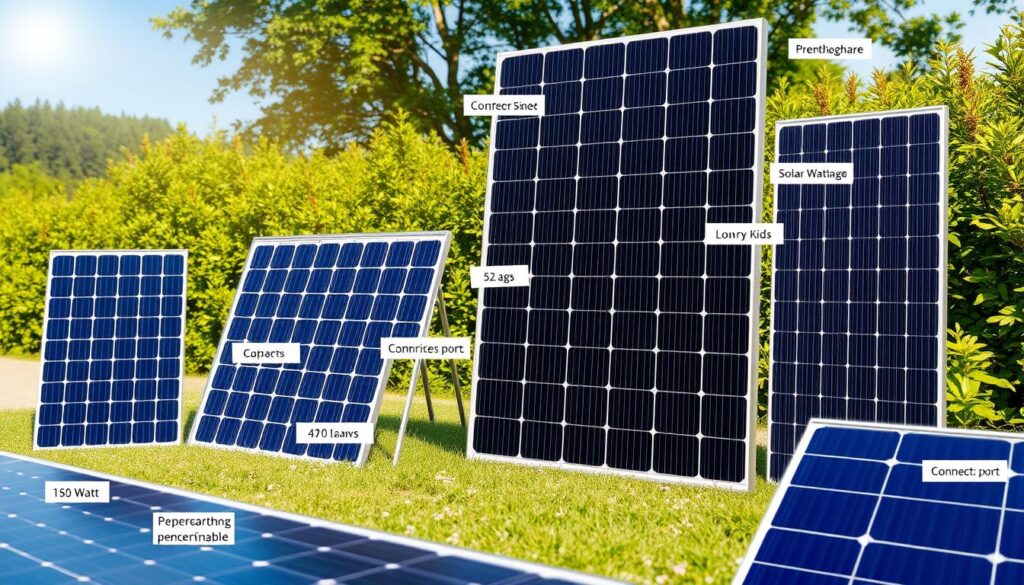
Charge controllers are also key. They manage electricity flow and protect the battery. They ensure the battery is charged right, avoiding damage. The right charge controller depends on your system’s needs, like panel and battery types.
Solar Panels and Specifications
Solar panels come in two main sizes: 60-cell and 72-cell. The size you choose depends on space and energy needs.
Charge Controllers
Charge controllers come in types like PWM and MPPT. MPPT controllers are more efficient and handle higher voltages, great for big systems.
Battery Types and Capacities
The battery types you pick depends on your energy needs and budget. Lead-acid batteries are affordable, while lithium-ion batteries last longer and hold more energy.
Knowing about solar panel specifications, charge controllers, and battery types helps you build a system that meets your energy needs. It ensures reliable performance.
Selecting the Right Solar Panel Size
To find the perfect solar panel size, you need to know the battery’s capacity and energy requirements. A good rule is to pick a solar panel that can give 1.5 to 2 times the battery’s capacity in watts. For example, a 100Ah battery needs a 150 to 200-watt solar panel for quick charging.
To figure out the solar panel size, multiply the battery’s amp-hours by its voltage. Then, divide by the desired charging time. For a 100Ah battery with a 12V voltage, you need a solar panel that can give 1200 watt-hours (Wh) of energy. To charge the battery in 10 hours, you’ll need a 120-watt panel.

When choosing a solar panel, remember the battery capacity and solar panel size. A bigger battery needs a bigger solar panel for efficient charging. Also, think about the energy requirements of your system. This ensures the solar panel can meet your system’s energy needs.
Understanding Solar Charge Controllers
Solar charge controllers are key in managing the flow of energy from solar panels to batteries and devices. They keep batteries charged without overdoing it, which can harm them. There are two main types: PWM and MPPT.
PWM vs MPPT Controllers
PWM controllers send short pulses of power that change based on the battery’s charge level. MPPT controllers, though, can handle more energy and transfer it more efficiently. They can get up to 94-98% efficient, giving 10-30% more power to batteries than PWM.
Controller Features to Consider
When picking a solar charge controller, think about these features:
- Efficiency: High ratings mean less energy loss.
- Compatibility: Make sure it works with your solar panels and batteries.
- Durability: Go for a controller built to last.

Knowing about solar charge controllers and their features helps you choose the right one for your solar system.
| Controller Type | Efficiency | Compatibility |
|---|---|---|
| PWM | 80-90% | Limited to specific PV arrays and batteries |
| MPPT | 94-98% | Compatible with a wide range of PV arrays and batteries |
Battery Types Compatible with Solar Charging
Choosing the right battery type is key for solar charging. There are many types, each with its own benefits and drawbacks. We’ll look at lead-acid, lithium-ion, and AGM and gel batteries.
Lead-Acid Batteries
Lead-acid batteries have been around for over a century. They’re affordable but have some downsides. They cost less and are easy to find, but they don’t last as long, usually 3-5 years.
Lithium-Ion Batteries
Lithium-ion batteries are the top choice for home solar systems. They pack a lot of energy and last a long time, up to 10 years or more. They also need little upkeep and can keep a charge for a long while.
AGM and Gel Batteries
AGM and gel batteries are also good for solar charging. They’re tough and need little care, making them great for off-grid systems.
Here’s a quick summary of each battery type:
| Battery Type | Lifespan | Energy Density | Maintenance Requirements |
|---|---|---|---|
| Lead-Acid | 3-5 years | Low | High |
| Lithium-Ion | 10+ years | High | Low |
| AGM and Gel | 5-10 years | Medium | Low |
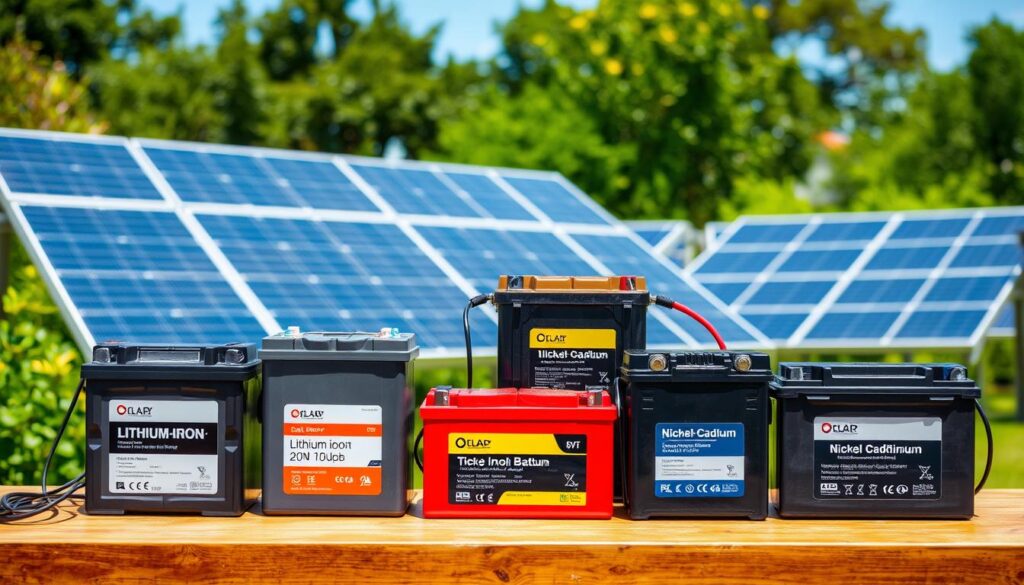
Setting Up Your Solar Battery Charging System
When you start with solar battery charging, setting up and installing your system is key. You need to know the parts and how they work together. A basic system has a solar panel, a charge controller, and a battery.
Choosing the right size for your solar panel and battery is important. For instance, a 30-watt solar panel can charge a 100-amp-hour battery well. It can almost fully charge it in a week. But, to charge it in a few days, you need at least 100 watts of solar power.
Here are some tips for setting up your solar battery charging system:
- Use a charge controller to prevent overcharging, which can damage the battery.
- Choose a solar panel that is compatible with your battery and charge controller.
- Ensure proper wiring and connections to avoid electrical shock or fire hazards.
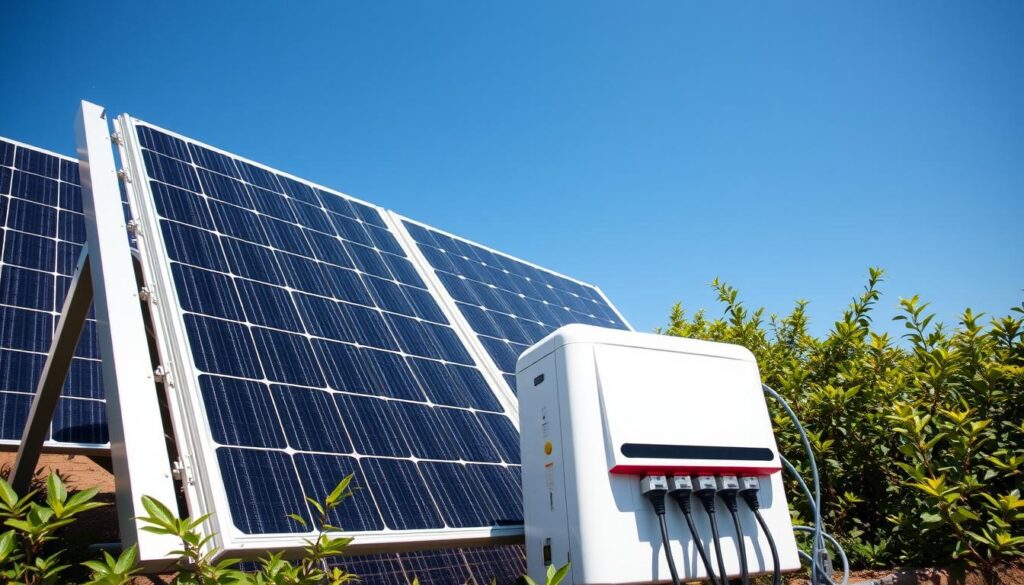
By following these tips and thinking about your system’s needs, you can have a safe and efficient installation. This will meet your energy needs.
Maximizing Charging Efficiency
To get the most out of your solar panels, think about panel positioning and maintenance. The right panel positioning can really boost energy output. For best results, tilt panels to a 45-degree angle, facing South in the North and North in the South.
Keeping your solar panels and batteries in top shape is key. This means checking fluids, cleaning panels, and watching voltage levels. By doing these things, you can make your solar system last longer, up to 10 years or more.
Here are some more ways to boost charging efficiency:
- Use Maximum Power Point Tracking (MPPT) technology to increase energy harnessing efficiency by up to 30%.
- Regularly check charge levels to keep batteries running well and slow down wear.
- Clean your solar panels often to get 10-30% more energy.

By using these tips and focusing on panel positioning and maintenance, you can make your solar battery system work better. This ensures it keeps performing well over time.
| Factor | Impact on Charging Efficiency |
|---|---|
| Panel Positioning | Significant impact, up to 20% increase in energy generation |
| Maintenance | Crucial for maintaining system health and longevity |
| MPPT Technology | Up to 30% increase in energy harnessing efficiency |
Common Solar Battery Charging Problems
Solar battery charging systems face issues like overcharging and undercharging. These can shorten the battery’s life. Regular maintenance helps avoid these problems and keeps the system running well. Troubleshooting is also vital to fix any issues that come up.
Common solar battery charging problems include bad connections, broken parts, and not enough sunlight. These can make the system less efficient. To fix these, it’s important to check and maintain the system regularly. This includes cleaning the solar panels and checking the wiring.
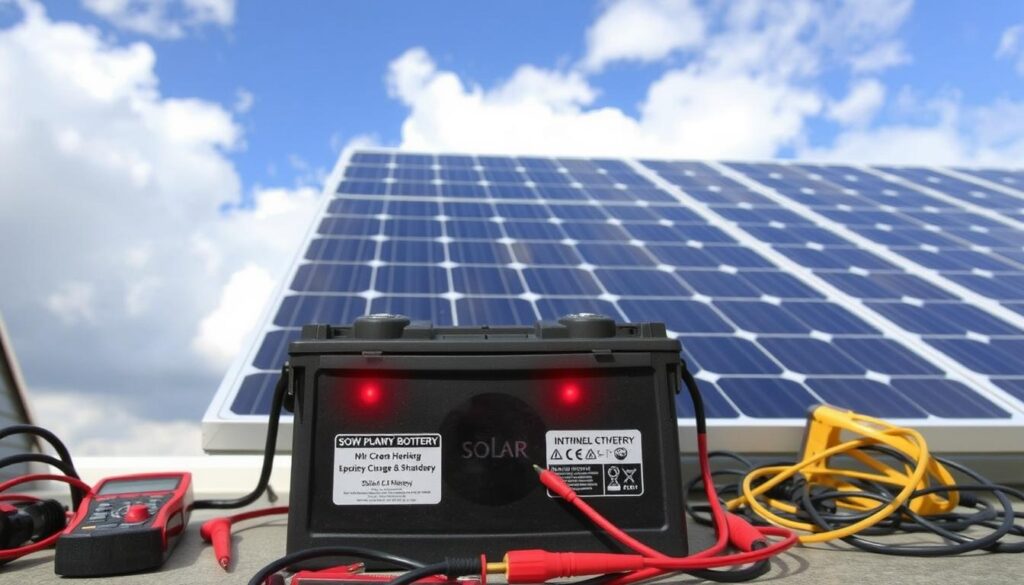
- Monitor the system regularly
- Perform routine maintenance tasks
- Ensure proper installation and setup
- Use high-quality components
By following these tips, you can lower the chance of solar battery charging problems. Regular troubleshooting and maintenance are key. They help prevent issues and make your solar battery system last longer.
Monitoring and Maintaining Your Solar Battery System
Regular solar battery maintenance is key to keeping your system running well. It means checking battery health and following a set schedule. This helps spot problems early on.
A well-kept solar battery system can last for many years. But, ignoring maintenance can cause it to work less well, be unsafe, or even fail. It’s important to check the battery levels weekly and clean it every few months.
Important things to remember in solar battery maintenance are:
- Operating temperature: Ideal temperature range for solar battery operation is between 20-25°C (68-77°F)
- Charge levels: Batteries perform best when maintained above a 50% capacity charge
- Cleaning: Regular cleaning is recommended every few months to ensure optimal performance
By sticking to a regular monitoring schedule and doing routine solar battery maintenance, you can make your system last longer. This means checking for wear, inspecting connections, and doing seasonal checks in spring and fall.
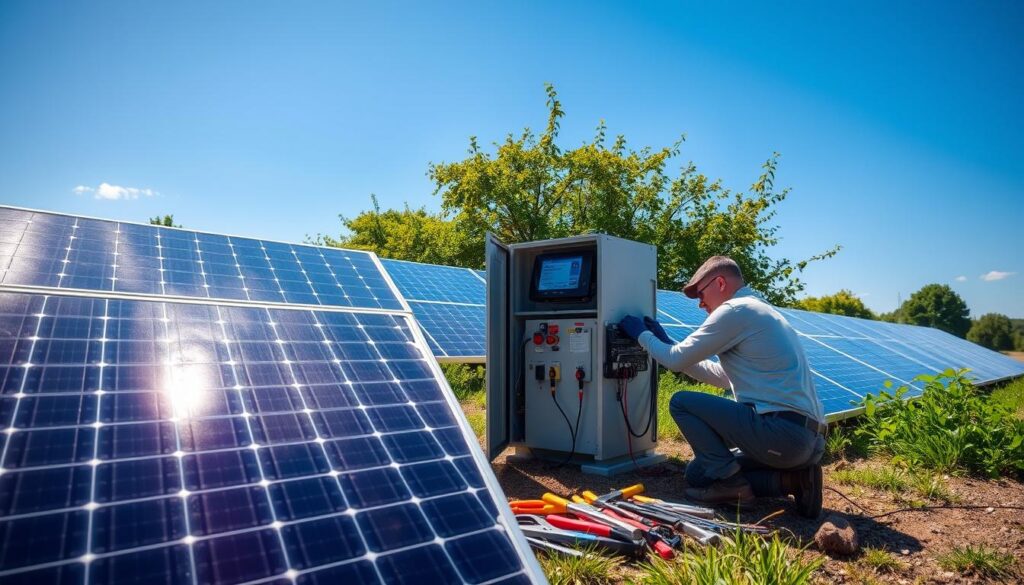
Also, using top-notch monitoring systems can boost your system’s efficiency. It gives you important info on how your solar battery system is doing. By focusing on solar battery maintenance and monitoring, your system will keep working well for a long time.
| Maintenance Task | Frequency |
|---|---|
| Check solar battery levels | At least once a week |
| Perform regular cleaning | Every few months |
| Seasonal maintenance checks | During spring and fall |
Cost Analysis of Solar Battery Charging
When you think about solar battery charging, it’s key to look at the costs. This includes the upfront price and the savings over time. A 12.5 kWh solar battery costs $18,791 to install in 2024. But, after a 30% tax credit, it drops to $13,154.
The cost per kWh for a 12.5 kWh battery-only project after the tax credit is $1,052. For a 12.5 kWh battery installed with solar, it’s $839. This big difference shows the long-term savings of choosing solar.

| Solar Battery Size (kWh) | Cost Installed with Solar |
|---|---|
| 6 kWh | $5,040 |
| 9 kWh | $7,560 |
| 12.5 kWh | $10,500 |
| 15 kWh | $12,600 |
| 18 kWh | $15,120 |
Investing in a solar-powered system can lead to big savings on energy bills over time. This makes the initial cost worth it.
Portable Solar Battery Chargers
Portable solar chargers are great for camping, RVing, or boating. They let you charge batteries with solar energy. This makes them perfect for outdoor lovers and those in remote places.
There are many portable solar chargers out there. You can find small, compact ones or bigger, more powerful ones. The Allpowers SP012 Solar Panel and the BigBlue 28W USB Solar Charger are popular. They have weatherproofing, flexibility, and multiple output ports.
Portable solar chargers offer many benefits. They provide off-grid energy, are easy to carry, and simple to use. They’re also good for those wanting to use renewable energy. Solar technology has improved, making these chargers more efficient and affordable.
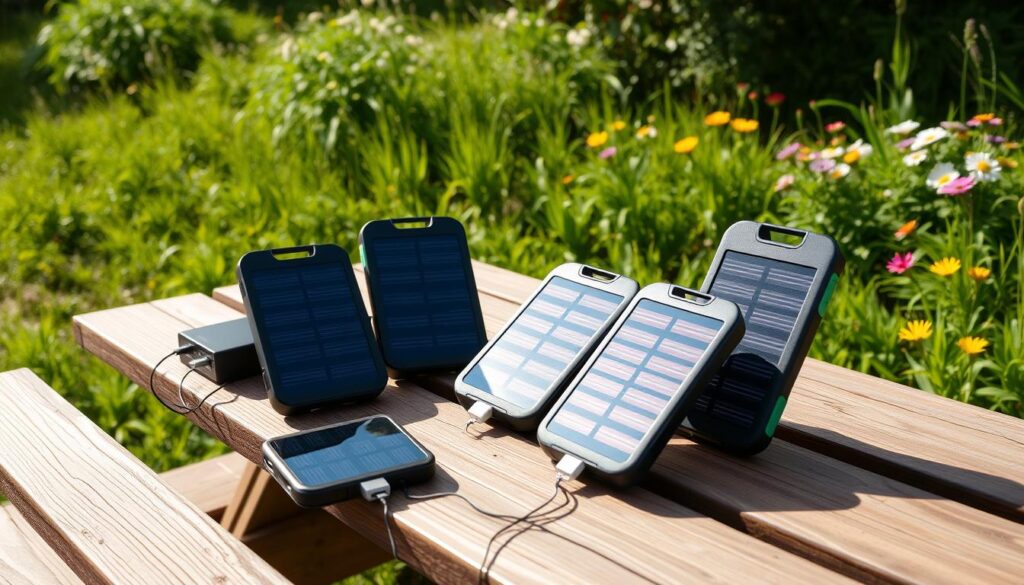
When picking a portable solar charger, look at its wattage, voltage, and efficiency. Also, consider the solar panel type. The charger’s size, weight, durability, and weather resistance are key. Choosing the right one lets you enjoy off-grid energyand cut down on traditional energy use.
| Product | Wattage | Voltage | Efficiency |
|---|---|---|---|
| Allpowers SP012 | 100W | 12V | 20% |
| BigBlue 28W | 28W | 12V | 15% |
Advanced Solar Battery Charging Techniques
Advanced solar charging methods can make solar battery systems more efficient and last longer. The way solar panels are set up is key. They can be in series or parallel. Series means panels are connected one after another, boosting voltage. Parallel means they’re side by side, increasing current.
Using more solar panels can speed up and improve charging. For example, proper charging practices can make lithium-ion batteries last up to 50% longer. This saves money on replacements. Solar charge controllers also boost efficiency by up to 30%, by fine-tuning voltage and current.
Series vs Parallel Configuration
In series setup, voltages add up, making the total voltage higher. This is good for batteries needing high voltage. Parallel setup, though, offers more flexibility and stable current.

Hybrid Systems
Hybrid systems mix different solar panels or energy sources for better efficiency and reliability. They might use series and parallel setups or add wind or hydro power. Advanced techniques like these help make solar battery systems more efficient and long-lasting.
Some benefits of these advanced methods include:
- Increased charging efficiency
- Improved battery lifespan
- Enhanced system flexibility
- Optimized energy output
By using these advanced techniques, people can get the best from their solar battery systems. This leads to a more sustainable and efficient energy solution.
Safety Considerations and Best Practices
When it comes to solar battery charging, safety is key. Proper installation and upkeep are vital for safe and efficient solar systems. This means regular checks on battery levels and smart charging methods like Maximum Power Point Tracking (MPPT).
To keep your solar system safe, avoid overcharging. It can shorten battery life by up to 30%. Also, keep batteries at about 50% charge if they’re not in use. By doing these things, you ensure your solar system works well and safely.
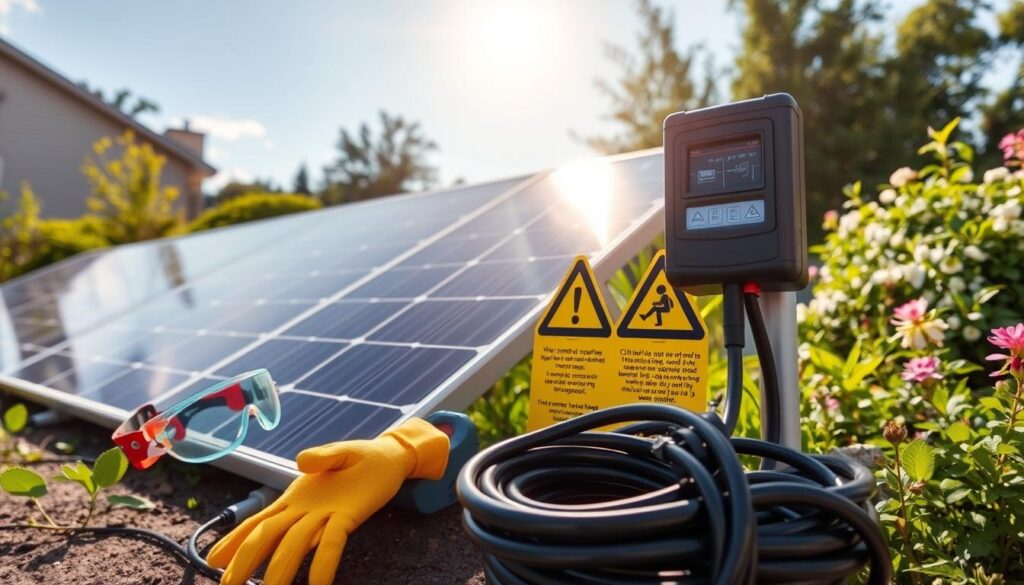
Important safety tips for solar battery charging safety include: * Keep an eye on battery charge levels * Use smart charging like MPPT * Don’t overcharge batteries * Store batteries at 50% charge * Make sure lead-acid batteries have good air flow Following these best practices and precautions helps your solar system run safely and efficiently.
| Battery Type | Lifespan | Depth of Discharge (DoD) Limit |
|---|---|---|
| Lithium-ion | 10-15 years | 80% |
| Lead-acid | 3-7 years | 50% |
Environmental Impact of Solar Battery Charging
Solar energy is clean and renewable. It’s great for charging batteries and cuts down on pollution. Using solar power helps reduce our carbon footprint and supports a greener future.
Solar battery charging systems also encourage recycling and safe battery disposal. This helps protect our environment. As we move towards cleaner energy, it’s key to lessen the environmental impact of solar charging.
Here are some benefits of solar battery charging:
- Less carbon footprint thanks to renewable energy
- More recycling and safe battery disposal
- Less harm to the environment with sustainable energy
As solar battery charging grows, we must focus on recycling and eco-friendly practices. This way, we can make sure our planet stays clean for future generations.

Future of Solar Battery Charging Technology
The future of solar battery charging technology is bright. Innovations and future developments are happening all the time. As we move towards renewable energy, the need for good solar battery charging systems grows.
Lithium-ion battery costs have dropped by nearly 85% from 2010. This makes solar-powered systems more affordable in the energy market.
New trends and innovations are changing solar battery charging. Advanced materials and artificial intelligence are making systems better. Solid-state batteries could boost energy density by up to 50%.
AI can also make batteries 20% more efficient. This is thanks to smart performance algorithms.

The solar industry is growing fast, with a 20% annual increase in capacity. We’ll see more exciting changes in solar battery charging technology. It could cut electricity costs by up to 50% and offer up to 80% of grid services.
Conclusion
Solar battery charging brings many benefits that can change how we use energy. It gives us freedom to live off the grid and saves money on electricity bills. The tech behind it, like better solar panels and batteries, makes it a great choice for many.
Using solar battery charging helps the planet and makes us more energy independent. It’s good for homes, businesses, and anyone who cares about the environment. It’s a smart way to power your life, from your home to your electric car.
The future of solar battery charging looks bright. We can expect better storage and smarter systems that work with our homes. By choosing this tech, you save money and help create a greener future for all.
FAQ
What is solar battery charging?
Solar battery charging uses solar panels to turn sunlight into electricity. This electricity then charges batteries.
How does solar charging work?
Solar charging turns sunlight into electrical energy with solar panels. This energy charges batteries through a charge controller.
What types of batteries can be charged with solar power?
You can charge many types of batteries with solar power. This includes lead-acid, lithium-ion, and AGM batteries.
What are the benefits of using solar power to charge batteries?
Using solar power to charge batteries has many benefits. It gives you energy independence, lowers energy costs, and is better for the environment.
What are the essential components of a solar battery charging system?
A solar battery charging system needs a few key parts. These are solar panels, charge controllers, batteries, and the right wiring and connections.
How do I determine the right solar panel size for my battery?
To find the right solar panel size, look at your battery’s capacity and energy needs. Then, calculate the panel size based on that.
What is the difference between PWM and MPPT solar charge controllers?
PWM and MPPT are two types of solar charge controllers. Each has its own benefits and features.
How do I set up a solar-powered battery charging system?
Setting up a solar-powered system involves connecting the solar panel, charge controller, and battery. Make sure it’s installed safely and efficiently.
How can I maximize the efficiency of my solar battery charging system?
To boost efficiency, position your panels right, adjust for seasons, and maintain your system regularly.
What are some common problems with solar battery charging systems?
Problems include overcharging, undercharging, and equipment failure. Troubleshooting and maintenance can solve these issues.
How do I monitor and maintain my solar battery charging system?
Check your battery’s health and follow a maintenance schedule. This keeps your system running well.
What are the cost considerations for a solar battery charging system?
Consider the initial cost, long-term savings, and ROI when evaluating a solar system’s value.
What are the benefits and applications of portable solar battery chargers?
Portable chargers offer convenience and flexibility. They’re great for many uses, making them very useful.
What are some advanced solar battery charging techniques?
Advanced techniques include series and parallel setups, and hybrid systems. Each has its own advantages and challenges.
What are the safety considerations and best practices for solar battery charging systems?
Safety is key. Ensure proper installation, maintenance, and precautions for safe and efficient operation.
What is the environmental impact of solar battery charging systems?
Solar systems are good for the environment. They reduce carbon footprint and support sustainable energy, including recycling.
What is the future of solar battery charging technology?
Solar technology is getting better, cheaper, and more versatile. This will make it even more popular for renewable energy.